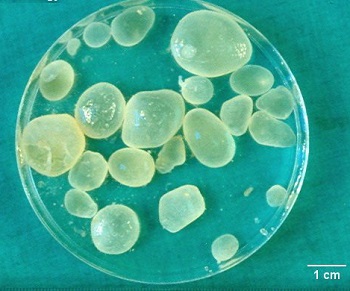Echinococcus granulosus - Introduction, Classification, History, Habitat, Morphology
Introduction of Echinococcus granulosus
The genus Echinococcus has four species that cause infection in humans- Echinococcus granulosus, Echinococcus multilocularis, Echinococcus vogeri, and Echinococcus oligarthrus. Echinococcosis is an infection caused by both the adult and larval stages while hydatid is an infection caused by the larvae (metacestode) of E. granulosus and E. multilocularis.
Echinococcus granulosus, also known as hydatid tapeworm or dog tapeworm, is the parasite that causes echinococcosis in man and other herbivores. Hydatid cyst is the larval stage of this parasite which is highly toxic and antigenic to humans.
Classification of Echinococcus granulosus
Phenotypically, Echinococcus granulosus is classified as:
Kingdom: Animalia
Phylum: Platyhelminthes
Class: Cestoda
Order: Cyclophyllidea
Family: Taeniidae
Genus: Echinococcus
Species: E. granulosus
History of Echinococcus granulosus
Echinococcus granulosus, in its adult form, was first described in 1695 by Hartmann from a dog intestine. Almost a century later, in 1782, the larval stage (hydatid cyst) was demonstrated by Goeze. Von Shiebold first described the life cycle of the parasite in 1853 while Naunyn demonstrated the hydatid cyst in a man’s bladder in 1893 proving it the worm stage of Echinococcus granulosus.
Habitat of Echinococcus granulosus
The adult tapeworms are found in dogs and wild canines where they remain attached to the wall of the intestinal mucosa.
The larval stage (hydatid cyst) of Echinococcus granulosus habitats in humans as well as herbivorous animals.
Morphology of Echinococcus granulosus
The morphological forms of Echinococcus granulosus include the adult form, larvae, eggs, and cysts.
Adult form
small - measures 3mm to 6mm in length
Echinococcus granulosus inhabits the small intestine of dogs
present in large numbers attached to the wall of the intestinal mucosa
consists of a head (scolex), neck, and body (strobila)

Image: E. granulosus adult (Source: ResearchGate)
Scolex
Echinococcus granulosus scolex is pyriform in shape
measures 300μm in diameter
has four suckers and two rows of hooks
Neck
Echinococcus granulosus neck is short and thick
Strobila
Echinococcus granulosus strobila consists of three segments or proglottids
first segment: immature
second segment: mature – narrowest proglottids
third/terminal segment: gravid – largest and broadest (2mm to 3mm in length and 0.6mm in breadth)
fourth segment: (if present) always gravid
the third segment contains several hundreds of eggs, does not have a uterine opening, and thus ruptures to release eggs before or after passing with stool
Larva
The larval form of Echinococcus granulosus is also known as the Hydatid cyst.
Hydatid cyst
Echinococcus granulosus hydatid cyst found in organs of man and other herbivores
contains scolex which is invaginated within a vesicular body
in humans, the cyst is unilocular, subspherical, and filled with fluids
at the end of one year, it measures around 5cm in diameter
cyst wall has two layers-
an outer laminated layer (ectocyst)
an inner germinal layer (endocyst)
ectocyst is tough elastic later, hyaline, milky, opaque, non-nucleated, laminated, measures 1mm thick, and is selectively permeable to macromolecules
the vital layer of the cyst- the endocyst is cellular, nucleated, measures 22nm to 25nm in thickness, gives rise to brood capsules with scolices, secretes hydatid fluid, and gives rise to the outer layer
some cysts called acephalocysts or sterile cysts lack brood capsules and even if the brood capsules are present- they lack scolices

Image: E. granulosus - cross section of hydatid cyst (Source: intechopen)
Hydatid fluid
Echinococcus granulosus hydatid fluid is a clear and colorless fluid that fills the interior of the cyst
nutritive as it provides nourishment for the growing brood capsules and scolices
is slightly acidic (pH 6.7), has a low specific gravity (1 to 1.010), and is rich in electrolytes (NaCl 0.5%, sodium sulfate, and salts of succinic acid
hydatid sand, a large number of brood capsules and protoscolices, can be seen floating in the Echinococcus granulosus hydatid fluid- resembling sand grains
fluid is highly toxic and antigenic
if a cyst ruptures inside the body, an anaphylactic reaction may prove fatal
.jpg)
Image: E. granulosus scoleces - Hydatid Sand (Source: webpathology)
Growing cysts
The growth rate of Echinococcus granulosus cysts is highly variable with an average growth of 1cm to 1.5cm per year. It is surrounded by three layers:
the outer layer (pericyst) – consists of only fibrous tissues and does not form any organic part of the cyst
middle layer – contains numerous fibroblasts, eosinophils, and newly formed blood vessels
inner later – contains radically arranged giant cells and eosinophils

Image: Echinococcus granulosus hydatid cysts removed from kidney (Source: webpathology)
Infective form
Eggs
infective form of Echinococcus granulosus
found in the feces of the dog
infective to man, sheep, cattle, and other intermediate hosts which are mostly herbivores
measures 31μm to 43 μm in diameter
spherical shape and brown in color
has two layers- an outer thin wall and inner embryophore
each egg has a hexacanth embryo with three pairs of hooklets
but the eggs are not morphologically different from that of the Taenia species

Image: E. granulosus egg in feces (Source: webpathology)